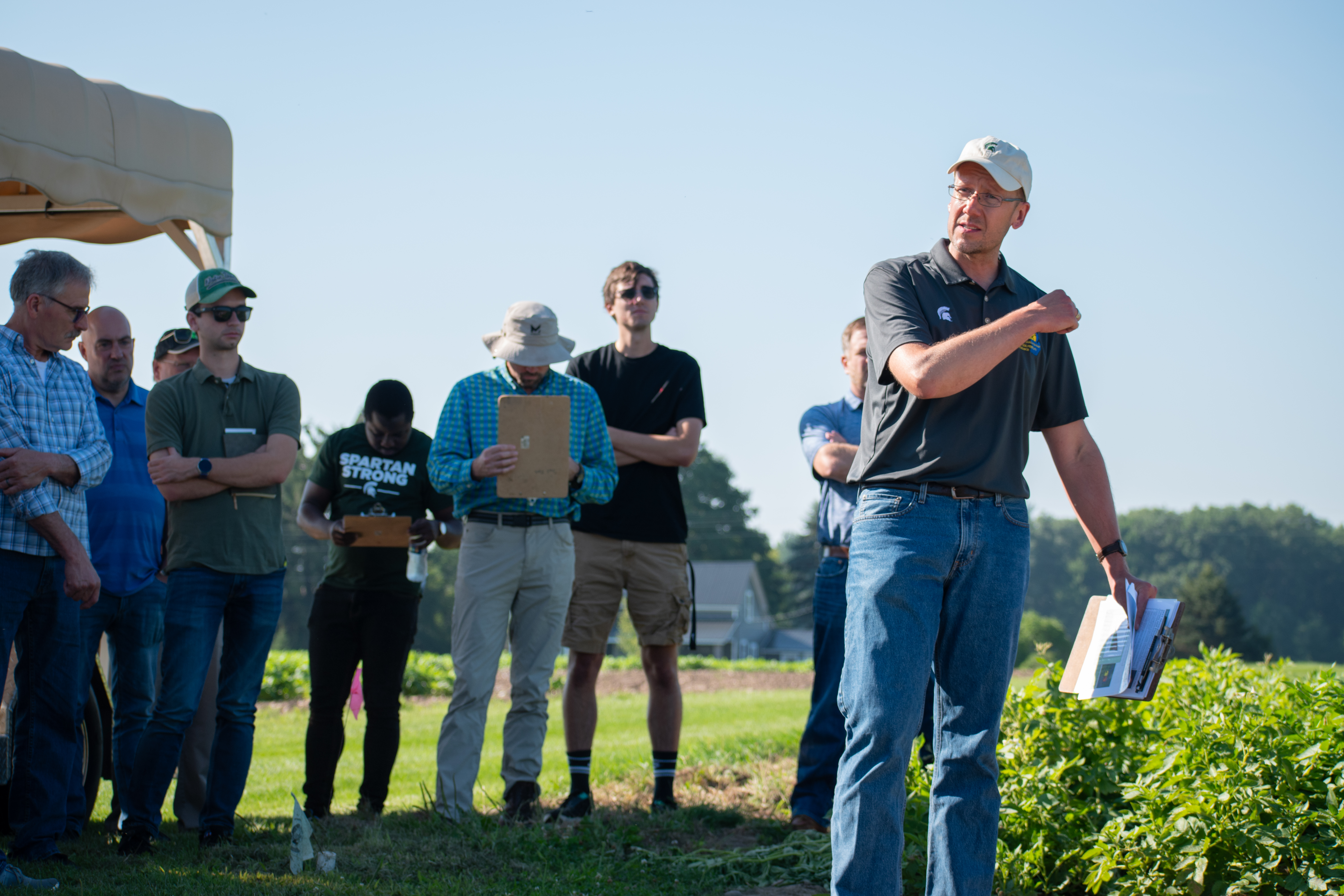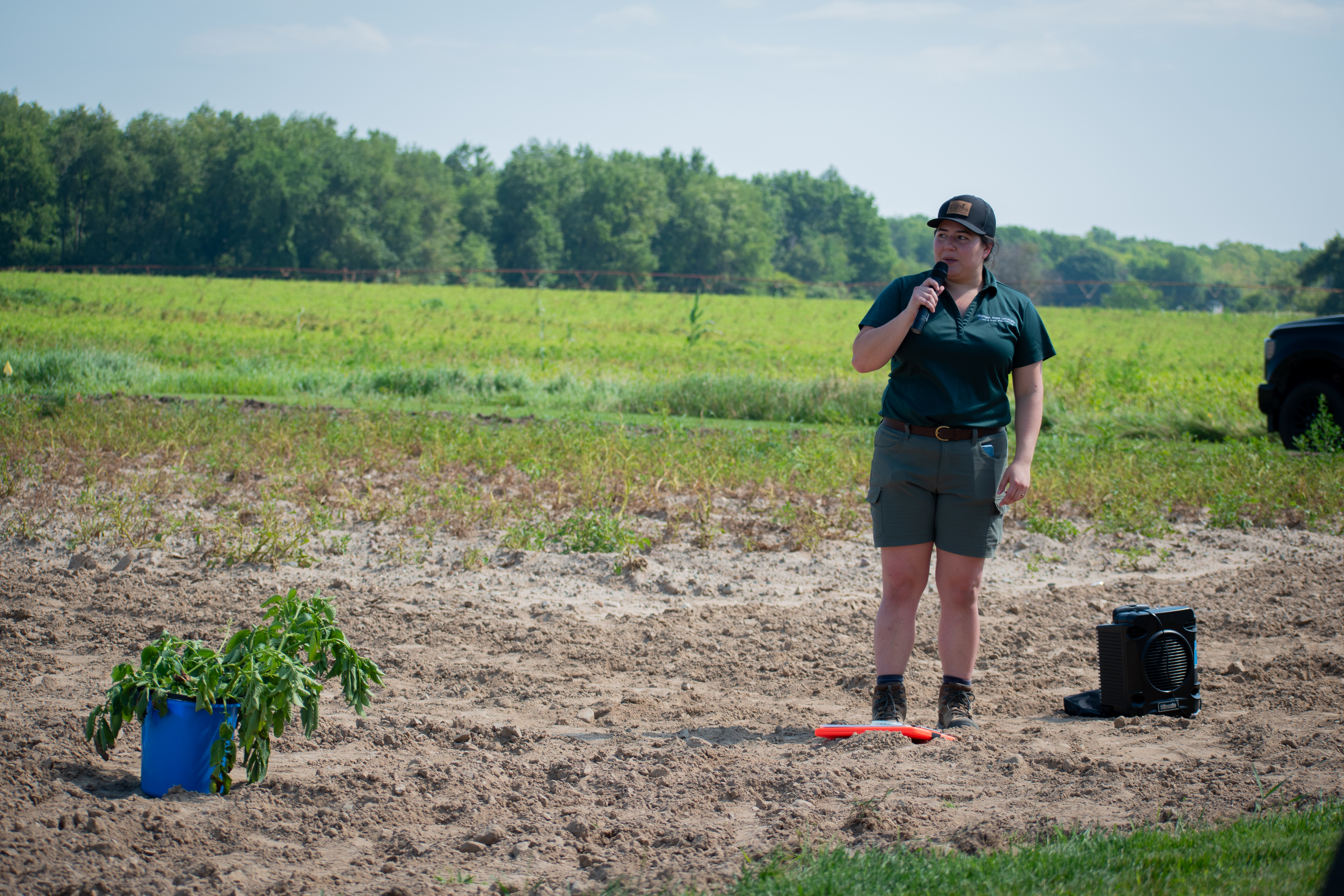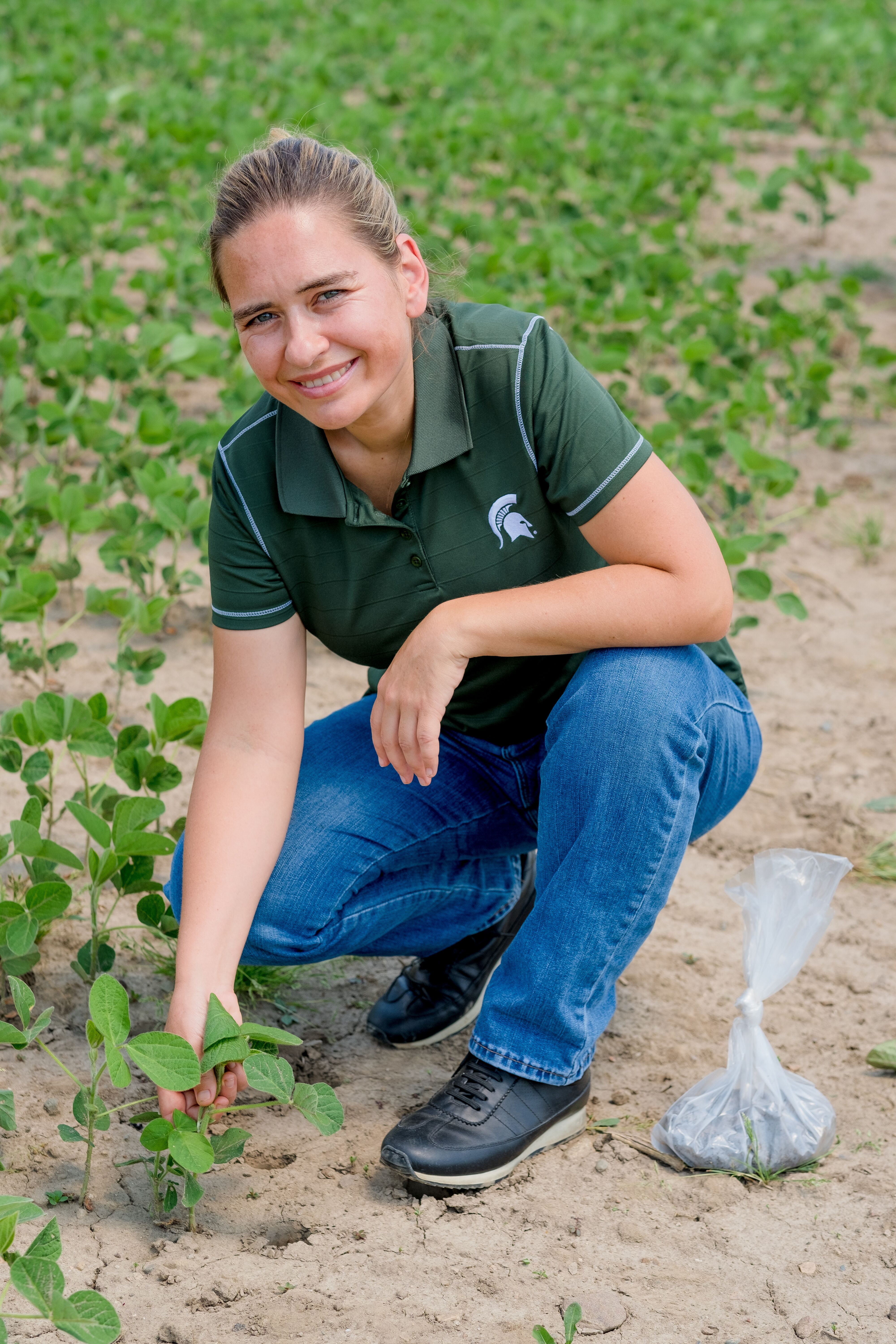MSU potato field day attracts industry professionals to discuss management techniques
Field day held at MSU AgBioResearch’s Montcalm Research Center

STANTON, Mich. — Potato nutrient and disease management were the highlights of conversation during Michigan State University Extension and MSU AgBioResearch’s field day Aug. 3.
The informational gathering included discussions amongst potato farmers across the state, workshops from MSU professors and research specialists, and a key-note presentation from Christopher Winslow, director of the Ohio Sea Grant Program at Ohio State University. It was held at MSU AgBioResearch’s Montcalm Research Center.
MSU presenters included:
- Erin Burns, assistant professor of integrated weed management.
- Marisol Quintanilla, assistant professor of applied nematology.
- Kurt Steinke, associate professor of soil fertility and nutrient management.
- Zsofia Szendrei, associate professor of agroecology.
- Jaime Willbur, assistant professor of integrated disease management in potato and sugar beet production.
Grower advisers Casey Carr of Sackett Potatoes and Stephanie Kipp of Kipp Farm Services, the Michigan Potato Industry Commission and additional agribusiness partners also lent their support in facilitating the event.
In 2022, Michigan farmers harvested more than 1.6 billion pounds of potatoes across 44,500 acres. Of those, 70 percent were used to make potato chips. The overall yield generated approximately $237 million.
Phosphorous on potato farms
An emphasis of Winslow’s presentation, and a recurring topic throughout the day, was the impact of applying and managing phosphorous on potato farms. While an important nutrient assisting in the transfer of energy from sunlight to plants and ultimately root growth, phosphorus can have negative impacts by running off farms and impacting algal blooms in freshwater ecosystems, including the Western Lake Erie Basin.
To help mitigate phosphorous runoff, experts encouraged farmers to practice the “4Rs” of nutrient management:
- Right source of fertilizer nutrients.
- Right rate (amount) of fertilizer nutrients.
- Right time (of year) to apply fertilizer nutrients.
- Right place (in the soil) to apply fertilizer nutrients.
Steinke discussed the soil and plant characteristics of potato cropping systems that often lead to reduced phosphorus efficiencies and greater phosphorus soil test values relative to other field crops.

Strategies like banding phosphorus fertilizer at planting can help protect against yield loss, but the potato response to phosphorus applications still depends on the phosphorus levels done at soil testing.
Phosphorus can absorb itself within soil particles or affix itself to the soil’s surface. This phosphorus, known as legacy phosphorus, can accumulate and export itself through field erosion, possibly moving into freshwater ecosystems.
Multiple factors such as the phosphorus soil test value, slope of a field, distance from a water source, conservation practices, and rainfall intensity and duration in an area must all be considered when evaluating the movement of legacy phosphorus into freshwater ecosystems.
Unnecessary phosphorus applications are an economic loss to growers and can be an environmental hazard. Steinke recommended that farmers test the soil to understand which and how much nutrients to apply.
“Soil sampling might not make (farmers) money, but it can save them money,” Steinke said.
Another way to address escaping phosphorus is to assess water management practices. Soluble phosphorus can travel through drainage water and leak into freshwater. Mitigation strategies include modifying drainage system designs, implementing saturated buffers that remove nutrients from drainage water, planting field buffers — like trees and shrubs — that absorb nutrients before reaching bodies of freshwater, and updating drainage ditch systems.
“Nutrient management and water management are difficult to separate or isolate because they each influence each other,” Steinke said.
Current work performed by MSU researchers is backed by the Michigan Department of Agriculture and Rural Development (MDARD) to examine agricultural conservation practices. Efforts are led by MSU associate professor Ehsan Ghane, who studies agricultural water management and water quality in MSU’s Department of Biosystems and Agricultural Engineering.
No late blight detected in Michigan
Experts said that this year in Michigan there has been no detection yet of late blight, a devastating foliar disease that impacts tomato and potato crops.
Willbur said she has been working with the MSU Potato Outreach Program, MSU Extension and the Michigan potato industry to sample the aerial spores – those released from the plant above ground – from potato crops to detect any signs of late blight. Sampling is currently deployed in three counties, including Montcalm County where potato late blight was detected not this year, but last.

The project is funded by Michigan Potato Industry Commission and Project GREEEN, a plant agriculture partnership among plant-based commodity groups, MDARD, MSU AgBioResearch and MSU Extension.
Steve Whittington, an MSU Extension field crops educator, said battery controlled spinning rods coated with a sticky vaseline-like material are used to collect the microscopic spores.
Whittington gathers the rods located throughout Montcalm County weekly, and an MSU technician tests them for late blight spores. If late blight is detected on the rods, farmers have an early warning to prepare for and control crop outbreaks.
The samplers were deployed in June this year. Whittington said he hopes that as this project progresses, it will be replicated to assist potato farmers statewide.
“We’ve got a couple big potato farmers in the region, and we work with all their agronomists to identify where the most strategic areas are to place these samplers,” Whittington said. “This project has been effective because it’s given us another tool to monitor a potential disease that could affect these crops.”
Examining potato early die complex
In addition to the research presented on late blight, Quintanilla presented research on potato early die complex. The destructive disease is caused by an attack on the root system from the soilborne fungus Verticillium dahliae and root-lesion nematode Pratylenchus penetrans.

Earlier this year, a team of researchers led by Quintanilla received a $750,000 grant from the U.S. Department of Agriculture’s National Institute of Food and Agriculture to evaluate and develop sustainable methods for managing potato early die complex.
Current methods of combatting the disease include fumigation, which can compromise the soil’s microbiome. Research conducted by Quintanilla and her team, including doctoral student Luisa Parrado and graduate student Abigail Palmisano, suggest that poultry manure and a compost blend are effective in countering the pathogens.
Prior to the grant, the team had already experimented with two treatment blends that’ll continue to be used for ongoing research. However, since the grant’s announcement, two additional compost and manure blends have been identified and will be included in the study.
Experiments will be conducted for the next two years. During the third year, extension agents and researchers will disseminate the results. Data from this year’s first growing season, which will occur at two different Michigan potato farms, will be collected next spring.



 Print
Print Email
Email




